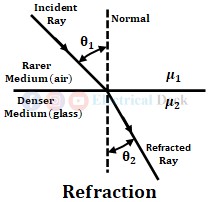Basically, there are four principles of light i.e., reflection, refraction, diffusion, and absorption. These four principles depend on the material of the surface, the angle of the incident light ray, and the medium being used. Hence based on these factors, some fraction of light may be reflected, a fraction of light may be refracted, a fraction of light may be diffused and a fraction of light may be absorbed.
Using these four principles, the light can be controlled in order to meet the required condition. Thus there are four light control methods, they are,
- Reflection,
- Refraction,
- Diffusion, and
- Absorption.
Using reflection and refraction the direction of light can be changed, using diffusion the light can be made to scatter in all directions in order to prevent glare, using absorption rays of light may be absorbed to prevent glare and to change the color of light.
Reflection :
Reflection is basically divided into two types,- Specular Reflection,
- Diffused Reflection.
Specular Reflection :
In this type of reflection, the light ray coming in one particular direction will be reflected in a unique direction. The incoming ray of light is called an incident ray and the outgoing ray of light is called a reflected ray. The angle made by the incident ray with respect to normal (θ1) will be equal to the angle made by the reflected ray with respect to normal (θ2) as shown in the figure below.
In this type of reflection, no part of the light will be scattered and hence it is also called perfect reflection or mirror reflection, or regular reflection. This type of reflection is basically the result of an incident of light on a smooth surface like a silvered mirror of highly polished surfaces.
The characteristics of specular reflection are,- The light ray after reflection continues in a unique direction.
- The same amount of light will be reflected without getting broken.
- The reflecting surface produces the image of the object from which light is emitted.
- The angle of incident is equal to the angle of reflection.
- This type of reflection is basically, the result of the smoothness of the surface.
Diffused Reflection :
In this type of reflection, the ray of light coming from one particular direction will be reflected in many directions as shown below. This is basically due to the roughness of irregularities of the surface which will cause the light to get scattered into a number of regular reflections i.e., the incoming ray of light (incident ray) will be broken into a number of outgoing rays (reflected rays).
This type of reflection is also called scattered or irregular reflection. This type of reflection is basically the result of an incident of light on rough surfaces like paper, chalk, etc.
The characteristics of diffused reflection are,- The light ray after reflection gets scattered in all directions.
- The incident ray gets broken into a number of reflected rays.
- The surface will be uniformly illuminated and appears to be bright from all directions.
- The angle of incident is not equal to the angle of reflection.
- This type of reflection is basically the result of the roughness of the surface.
From the above analysis, it is clear that in the case of specular reflection, the ray of light is completely reflected and in the case of diffused reflection, it is completely scattered. This is true only under the ideal condition which is practically not possible i.e., we can never create 100% smooth or 100% rough (mat) surfaces.
Hence in the case of specular as well as diffuse reflection, part of the light will be refracted, absorbed, partly diffused, and partly reflected. The percentage of each depends on the properties of the surface and the medium being used.
Refraction :
The refraction of light takes place when a light ray passes through two mediums having different densities. Due to the change in density of the medium, the light ray when enters, its velocity, and direction will be changed as shown below.
In the above figure, the light ray passes from a rare medium (air) having a refractive index μ1 to a dense medium (glass) having a refractive index μ2, the angle of light with normal (θ1) in the dense medium is comparatively less than the angle of light with normal (θ2) in the rare medium.
Diffusion :
The phenomenon in which a light ray falling on a surface is reflected or transmitted in all possible directions i.e., the surface can be seen from all possible directions, is known as diffusion. The diffusion of light is also known as scattering. It can be achieved by using a glass screen between the light source and the observer. Generally, opal or frosted glasses are used for the diffusion of light.
Absorption :
The absorption technique of light control is employed for controlling the glare of a light source. When there is an excess of light rays coming from the light source. In order to avoid unwanted light rays coming out from the light source, the absorption principle is used. The absorption of light can be achieved by using special bluish-colored glass around the light source which absorbs unwanted light rays.
During the phenomenon of absorption of light, some amount of light rays from the light source is transferred to the absorption material (glass around the light source) without being reflected or transmitted as shown above. Thus in this way, the number of light rays from a light source can be controlled.




